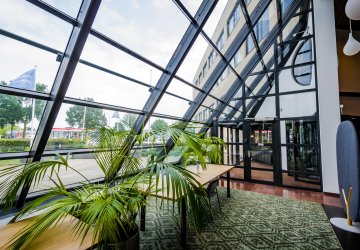
Organizations and more specifically, their Facility and Real Estate managers, are constantly looking to improve their work environments and the buildings that they work in. They want to be cost efficient, increase productivity, and create a healthy and attractive workplace for their employees (which is very important these days). The Internet of Things and Smart Buildings are providing interesting opportunities to improve our work environments. Achieving this however, is a big challenge for most organizations. What Smart Building solutions are organizations looking for? What is the real value for organizations? And most importantly, how will organizations realize these benefits?
From a reactive to a proactive approach through “machine learning”
The ability of buildings to measure every action or change in behavior by the building or its occupants is progressing rapidly. For examples, in today’s world, affordable sensors are available that measure space occupancy, air quality, usage of specific spaces or the state of building installations. Data collected from these sensors provides insight for making improvements to the work environment, building or user experience. For example, when sensor measurements show that a meeting room that was reserved is not in use, it can immediately become available for a new meeting. In addition, when sensor measurements show that a specific bathroom facility is used less than expected, the cleaning schedule can be adjusted. However, these useful examples are based on an “If this, then that” scenario, meaning that if an event occurs, we react to that event. This is a reactive approach rather than a proactive approach, so can we really call this “smart”?
As my colleague David Karpook describes in an article “How Buildings Learn” the intelligence of buildings is rapidly evolving to the next level. Buildings “sense” their own behavior and that of their occupants. The Internet of Things provides buildings and equipment with the ability to collect, aggregate and analyze data. Additionally, “machine learning” enables buildings to learn, make predictions and become so-called “learning” buildings.
Machine learning is a method that allows us to make reliable, repeatable decisions by learning from historical relationships and trends in the data. Buildings that can learn and predict are becoming connected, human-centric and intelligent workspaces with an intuitive awareness, learning and predictive ability (of e.g. occupancy and utilization). Buildings really become “smart,” which enables employees to do their jobs faster, and enables organizations to create an efficient, effective and attractive workplace. This makes “life” easier for facility and real estate managers to monitor, manage, learn and make predictions about their buildings and to allow improvements. For example, with learning and predictive analysis, the facility manager or real estate manager pro-actively adapts the space to meet demand, while enabling longer-term strategic space and real estate decision-making.
What is the value of smart and learnable buildings?
This is just one example of the potential value of smart and learnable buildings. The Internet of Things and Smart Buildings provide us with an enormous potential of cases. However, what is the real value of measuring all these types of behavior and collecting data from the building and their occupants? Also, how and when do we create smart solutions in and around our buildings? In Planon’s white paper “Transforming smart building technology” you can learn about a real-time and dynamic integration of a smart building technology platform with an IWMS. This integration drastically improves the performance of both buildings and business by providing better alignment between your portfolio strategy and its technical performance and needs.
For facility and real estate managers, it is crucial to research what use cases are relevant and valuable to their organization. What smart solutions is the organization looking for? Are these actually smart solutions and do they provide learning and predictive analysis? In addition, organizations must determine what the specific business case from both a quantitative (costs) and/or qualitative (user experience, building performance) perspective for each relevant use case is. What is the real value of the use case and related smart solution? Establishing your use case and business case for your Smart and Learning Building solution is where the smart journey starts to an attractive, healthy, efficient and effective workplace that supports the organization’s objectives.
If you are interested in learning more about smart buildings, you should watch our webinar, “Turning Smart Building Diagnostics into Smart Actions.”



















